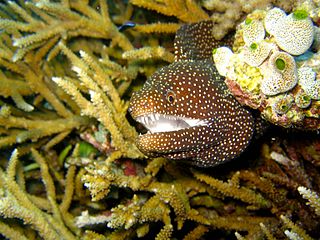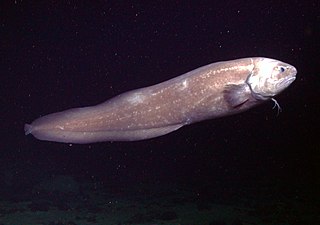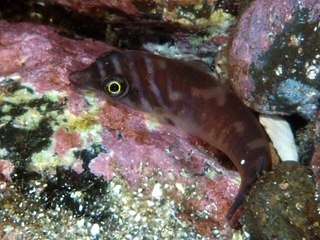
Moray eels, or Muraenidae, are a family of eels whose members are found worldwide. There are approximately 200 species in 15 genera which are almost exclusively marine, but several species are regularly seen in brackish water, and a few are found in fresh water.

The cusk-eel family, Ophidiidae, is a group of marine bony fishes in the Ophidiiformes order. The scientific name is from the Greek ophis meaning "snake", and refers to their eel-like appearance. True eels, however, diverged from other ray-finned fish during the Jurassic, while cusk-eels are part of the Percomorpha clade, along with tuna, perch, seahorses, and others.

Clingfishes are fishes of the family Gobiesocidae, the only family in the order Gobiesociformes. These fairly small to very small fishes are widespread in tropical and temperate regions, mostly near the coast, but a few species in deeper seas or fresh water. Most species shelter in shallow reefs or seagrass beds, clinging to rocks, algae and seagrass leaves with their sucking disc, a structure on their chest.

The New Zealand longfin eel, also known as ōrea, is a species of freshwater eel that is endemic to New Zealand. It is the largest freshwater eel in New Zealand and the only endemic species – the other eels found in New Zealand are the native shortfin eel, also found in Australia, and the naturally introduced Australian longfin eel. Longfin eels are long-lived, migrating to the Pacific Ocean near Tonga to breed at the end of their lives. They are good climbers as juveniles and so are found in streams and lakes a long way inland. An important traditional food source for Māori, who name them ōrea, longfin eel numbers are declining and they are classified as endangered, but over one hundred tonnes are still commercially fished each year.

Gymnothorax is a genus of fish in the family Muraenidae found in Atlantic, Indian and Pacific Ocean. With more than 120 species, it the most speciose genus of moray eels.

The Kidako moray is a species of marine fish in the family Muraenidae. It inhabits coral reefs or lagoons and could be found in tropical and subtropical seas near Taiwan, Japan, and Australia. The species is diurnal, which means it is more active in the daytime than the nighttime. It is also piscivorous: it consumes fish, octopus, and squid. Other than the Kidako moray, there are about 200 species of moray eels in the Muraenidae family. The Kidako moray would not attack humans unless they are provoked. However, due to the menacing looks of the Kidako moray and moray eels in general, they are feared by divers and snorkelers.
Mastacembelus is a genus of many species of spiny eel fish from the family Mastacembelidae. They are native to Africa and Asia. Most are found in rivers and associated systems, but there are also species in other freshwater habitats and a particularly rich radiation is found in the Lake Tanganyika basin with 15 species. A few species can even occur in brackish water.

The ring-tailed cardinalfish is a widespread fish species in the family Apogonidae found in the Red Sea and off East Africa to Papua New Guinea, north to Japan, and south to Australia.

Schultz's pipefish, Corythoichthys schultzi, is a pipefish of the family Syngnathidae.

Cavefish or cave fish is a generic term for fresh and brackish water fish adapted to life in caves and other underground habitats. Related terms are subterranean fish, troglomorphic fish, troglobitic fish, stygobitic fish, phreatic fish and hypogean fish.

Raitt's sand eel, also known as the lesser sand eel, is a small semi-pelagic ray-finned fish found in the North Atlantic Ocean. The Raitt's sand eel is member of the family Ammodytidae which includes all 31 species of sand eels, often referred to as sand lances. Contrary to their name sand eels, including Raitt's sand eel, are not true eels and instead belong to the order of “weever-like” fishes, the Trachiniformes.

Eels are ray-finned fish belonging to the order Anguilliformes, which consists of eight suborders, 20 families, 164 genera, and about 1000 species. Eels undergo considerable development from the early larval stage to the eventual adult stage and are usually predators.

Protanguilla palau is a species of eel, the only species in the genus Protanguilla, which is in turn the only genus in its family, Protanguillidae. Individuals were found swimming in March 2010 in a deep underwater cave in a fringing reef off the coast of Palau.

Opecoelidae is a family of trematodes. It is the largest digenean family with over 90 genera and nearly 900 species, almost solely found in marine and freshwater teleost fishes. It was considered by Bray et al. to belong in the superfamily Opecoeloidea Ozaki, 1925 or the Brachycladioidea Odhner, 1905.

Pictilabrus is a genus of wrasses endemic to the eastern Indian Ocean waters of Australia first discovered in 1940.

The common shore eel is a species of clingfish from Australia. It is generally found in the south-eastern waters of Australia. It usually grows to about 12 cms. Often found by beachgoers after looking in rock-pools and turning over shells.
The dwarf shore eel is a species of clingfish from the family Gobiesocidae.It is a small species which attains a maximum total length of 4.5 centimetres (1.8 in). This species is transparent and its internal organs are clearly visible through its skin. It occurs at depths of 0 to 5 metres within beds of seagrass and sometimes in nearby reefs. It is endemic to southern Australia where its range extends from near Sydney in New South Wales to Houtman Abrolhos in Western Australia, including the northern and eastern coasta of Tasmania. This species was described by Victor G. Springer and Thomas H. Fraser in 1976 and the specific name honours the ichthyologist Douglass F. Hoese of the Australian Museum who provided Springer and Fraser with much of the material they used in their description.
The pygmy shore eel is a species of clingfish from the family Gobiesocidae. It is endemic to south eastern Australia where it can be found within seagrass beds and sometimes on rocky reefs at depths of less than 10 metres (33 ft) from Point Cartwright in Queensland to Flinders Island, South Australia; its range includes Tasmania. This species was described as Cheilobranchus parvulus by Allan Riverstone McCulloch in 1909 from a type locality of rockpools near Sydney.

The electric eels are a genus, Electrophorus, of neotropical freshwater fish from South America in the family Gymnotidae. They are known for their ability to stun their prey by generating electricity, delivering shocks at up to 860 volts. Their electrical capabilities were first studied in 1775, contributing to the invention in 1800 of the electric battery.
Eric Oswald Gale Scott was an Australian teacher, museum director, ichthyologist and pacifist. He was the director of the Queen Victoria Museum and Art Gallery in Launceston.
















